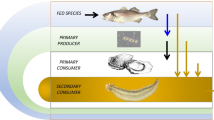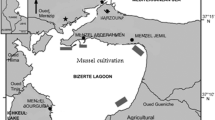Abstract
Practices of aquaculture production may generate potential pollutants that cause environmental pressure. In this context, a recommendation to mitigate the environmental impacts caused by aquaculture waste would be using and recycling such nutrients, considered as “pollutants,” in an eco-efficient way, with approaches such as the integrated multi-trophic aquaculture (IMTA). This system integrates the culturing of organisms with different and complementary ecosystem functions. This study aimed to investigate the ecosystem capacity of Ulva lactuca in wastewater bioremediation in an IMTA system with mussel and fish effluents. For such, three systems were set up: (1) algae cultivated with seawater, (2) algae with effluent from fish, and (3) algae with effluent from fish and mussels. Ulva lactuca proved to be a suitable species for the IMTA system with high growth and easy handling in cultivation. Algal growth rate, nutrient uptake (N and P) and O2 production increased significantly as the succession of trophic levels increased, demonstrating the high ecosystem capacity of U. lactuca for wastewater bioremediation as well as the use and recycling of eutrophication agents for biomass production. The highest absorption/removal of dissolved nitrogen occurred in the form of NH4+, a N form with the greatest metabolic advantage for photosynthetic assimilation, but toxic in high concentrations. The present IMTA system showed a balance between inputs and outputs, denoting sustainable and efficient characteristics of several ecosystem goods and services.







Similar content being viewed by others
References
Alexander KA, Hughes ADA (2017) A problem shared: technology transfer and development in European integrated multi-trophic aquaculture (IMTA). Aquaculture 473:13–19
Armstrong FAJ, Williams PM, Strickland JDH (1966) Photo-oxidation of organic matter in sea water by ultraviolet radiation, analytical and application. Nature 5048:481–463
Armstrong FAJ, Tibbits S (1968) Photochemical combustion of organic matter in sea water for nitrogen, phosphorus and carbon determination. J Mar Biol Assoc UK 48:143–152
Braga ES (1997a) Determinação automática de nitrato. In: Wagener ARL, Carreira R (eds) Métodos analíticos de referência em Oceanografia Química. Rio de Janeiro, MMA/SMA, 6:27–29
Braga ES (1997b) Determinação automática de nitrito. In: Wagener ARL, Carreira R (eds) Métodos analíticos de referência em Oceanografia Química. Rio de Janeiro, MMA/SMA, 7:31–35
Buschmann AH, Varela DA, Hernández-González MC, Huovinen P (2008) Opportunities and challenges for the development of an integrated seaweed-based aquaculture activity in Chile: determining the physiological capabilities of Macrocystis and Gracilaria as biofilters. J Appl Phycol 20:571–577
Chopin T, Kerin BF, Mazerolle R (1999) Phycocolloid chemistry as a taxonomic indicator of phylogeny in the Gigartinales, Rhodophyceae: a review and current developments using Fourier transform infrared diffuse reflectance spectroscopy. Phycol Res 47:167–188
Chopin T, Buschmann AH, Halling C, Troell M, Kautsky N, Neori A, Kraemer GP, Zertuche-González JA, Yarish C, Neefus C (2001) Integrating seaweeds into aquaculture systems: a key towards sustainability. J Appl Phycol 37:975–986
Chopin T, Robinson S (2004) Defining the appropriate regulatory and policy framework for the development of integrated multi-trophic aquaculture practices: introduction to the workshop and positioning of the issues. Bull Aquacult Assoc Canada 104:4–10
Chopin T, Robinson S (2006) Ration for developing integrated multi-trophic aquaculture (IMTA): an example from Canada. Fish Farmer Mag 65:20–21
Chopin T, Neori A, Buschmann A, Pang S, Sawhney M (2011) Diversification of the aquaculture sector. Seaweed cultivation, integrated multi-trophic aquaculture, integrated sequential biorefineries. Global Aquaculture Advocate 14:58–60
Chow F, Macchiavello J, Santa Cruz S, Fonck E, Olivares J (2001) Utilization of Gracilaria chilensis (Rhodophyta: Gracilariaceae) as a biofilter in the depuration of effluents from tank cultures of fish, oysters, and sea urchins. J World Aquacult Soc 32:215–220
Chow F, Pedersén M, Oliveira MC (2013) Modulation of nitrate reductase activity by photosynthetic electron transport chain and nitric oxide balance in the red macroalga Gracilaria chilensis (Gracilariales, Rhodophyta). J Appl Phycol 25:1847–1853
Cohen I, Neori A (1991) Ulva lactuca biofilters for marine fishpond effluents. I. Ammonia uptake kinetics and nitrogen content. Bot Mar 34:475–482
Edwards P, Pullin RSV, Gartner JA (1988) Research and education for the development of integrated crop-livestock-fish farming systems in the tropics. ICLARM Stud Rev 16:1–53
Ertör I, Ortega-Cerdà M (2015) Political lessons from early warnings: marine finfish aquaculture conflicts in Europe. Mar Policy 51:202–210
FAO (2016) The state of world fisheries and aquaculture 2016. Contributing to food security and nutrition for all. FAO, Rome
Grasshoff K, Kremling K, Ehrhardt M (1999) Methods of seawater analysis, 3rd edn. Wiley-VCH, Weinheim
Haines KC, Wheeler PA (1978) Ammonium and nitrate uptake by the marine macrophytes Hypnea musciformis (Rhodophyta) and Macrocystis pyrifera (Phaeophyta). J Phycol 14:319–324
Irisarri J, Fernández-Reiriz MJ, Cranford P, Shawn MC (2015) Availability and utilization of waste fish feed by mussels Mytilus edulis in a commercial integrated multi-trophic aquaculture (IMTA) system: a multi-indicator assessment approach. Ecol Indic 48:673–686
Lee TM, Tsai PF, Shyu YT, Sheu F (2005) The effects of phosphite on phosphate starvation responses of Ulva lactuca (Ulvales, Chlorophyta). J Phycol 41:975–982
Lignell A, Pedersén NM (1989) Agar composition as a function of morphology and growth rate. Studies on some morphological strains of Gracilaria secundata and Gracilaria verrucosa (Rhodophyta). Bot Mar 32:219–227
Martínez-Espiñeira R, Chpoin T, Robinson S, Noce A, Knowler D, Yip W (2015) Estimating the biomitigation benefits of integrated multi-trophic aquaculture: a contingent behavior analysis. Aquaculture 437:182–194
Neori A (1991) Use of seaweed biofilters to increase mariculture intensification and upgrade its effluents. Rev Fish Israel 24:171–179 (in Hebrew)
Neori A, Krom SP, Ellner CE, Boyd D, Popper R, Rabinovitch PJ, Davison O, Dvir D, Zuber M, Ucko D, Gordin H (1996) Seaweed biofilters as regulators of water quality in integrated fish-seaweed culture units. Aquaculture 141:183–199
Neori A, Ragg NLC, Shpigel M (1998) The integrated culture of seaweed, abalone, fish and clams in modular intensive land-based systems: II. Performance and nitrogen partitioning within an abalone (Haliotis tuberculata) and macroalgae culture system. Aquac Eng 17:215–239
Neori A, Shpigel M (1999) Algae treat effluents and feed invertebrates in sustainable integrated mariculture. World Aquac 30:46–51
Neori A, Shpigel M, Ben-Ezra D (2000) A sustainable integrated system for culture of fish, seaweed and abalone. Aquaculture 186:279–291
Neori A, Chopin T, Troell M, Buschmann AH, Kraemer GP, Halling C, Shipigel M, Yarish C (2004) Integrated aquaculture: rationale, evolution and state of the art emphasizing seaweed biofiltration in modern mariculture. Aquaculture 231:361–391
Robertson-Andersson DV, Potgieter M, Hansen J, Bolton JJ, Troell M, Anderson RJ, Halling C, Probyn T (2008) Integrated seaweed cultivation on an abalone farm in South Africa. J Appl Phycol 20:579–595
Ryther JH, Corwin N, Debusk TA, Williams LD (1981) Nitrogen uptake and storage by the red algae Gracilaria tikvahiae McLachlan 1979. Aquaculture 26:107–115
Saraiva ESBG (2003) Nitrogênio e fósforo totais dissolvidos e suas frações inorgânicas e orgânicas: Considerações sobre a metodologia aplicada e estudo de caso em dois sistemas estuarinos do estado de São Paulo. Thesis, Institute of Oceanography, University of Sao Paulo
Schuenhoff A, Shpigel M, Lupatsch I, Ashkenazi A, Msuya FE, Neori A (2003) A semirecirculating, integrated system for the culture of fish and seaweed. Aquaculture 221:167–181
Shpigel M, Neori A (1996) The integrated cultures of seaweed, abalone, fish and clams in modular intensive land-based systems: I. Proportions of size and projected revenues. Aquac Eng 15:313–326
Tiller R, Brekken T, Bailey J (2012) Norwegian aquaculture expansion and integrated coastal zone management (ICZM): simmering conflicts and competing claims. Mar Policy 36:1086–1095
Topinka JA (1978) Nitrogen uptake by Fucus spiralis (Phaeophyceae). J Phycol 14:241–247
Tréguer P, Le Corre P (1975) Manuel d’analysis des sels nutritifs dans l’eau de mer. 2ème éd. Brest, Université de Bretagne Occidentale
Troell M, Halling C, Neori A, Buschmann AH, Chopin T, Yarish C, Kautsky N (2003) Integrated mariculture: asking the right questions. Aquaculture 226:69–90
Wang X, Olsen LM, Reitan KI, Olsen Y (2012) Discharge of nutrient wastes from salmon farms: environmental effects, and potential for integrated multi-trophic aquaculture. Aquacult Environ Interact 2:267–283
Wood ED, Armstrong FA, Richards FA (1967) Determination of nitrate in seawater by cadmium-cooper reduction nitrite. J Mar Biol Ass UK 47:23–31
Zar JH (1996) Biostatistical analysis, 3rd edn. Prentice-Hall International Editions, New Jersey
Acknowledgments
The first author thanks Daniel Eduardo Lavanholi de Lemos for the infrastructure facilities, Luis Felipe de Freitas Fabrizio and Ricardo Otta for help in the construction and maintenance of cultivation systems, FC thanks CNPq for the productivity fellowship (Proc. 303937/2015-7).
Author information
Authors and Affiliations
Corresponding author
Rights and permissions
About this article
Cite this article
Nardelli, A.E., Chiozzini, V.G., Braga, E.S. et al. Integrated multi-trophic farming system between the green seaweed Ulva lactuca, mussel, and fish: a production and bioremediation solution. J Appl Phycol 31, 847–856 (2019). https://doi.org/10.1007/s10811-018-1581-4
Received:
Revised:
Accepted:
Published:
Issue Date:
DOI: https://doi.org/10.1007/s10811-018-1581-4




